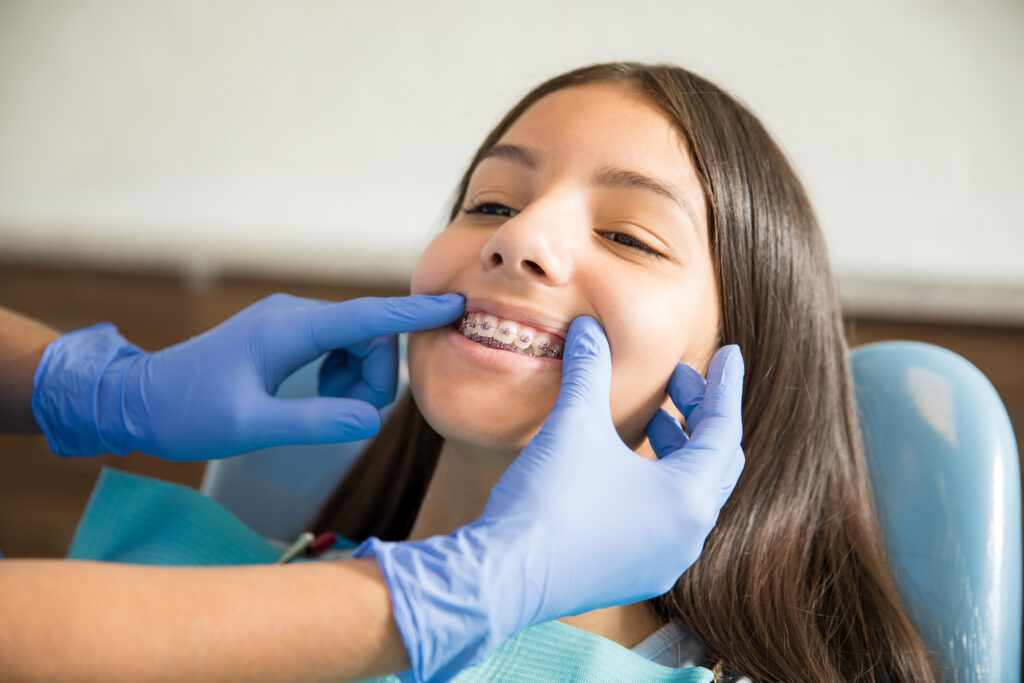Orthodontics and Aligners
Orthodontic treatment improves bad bites. Though orthodontics can enhance a smile at any age, there is an optimal time period to begin treatment. Beginning treatment at this time ensures the greatest result.

Best time to begin orthodontics
Though orthodontics can enhance a smile at any age, there is an optimal time period to begin treatment. Beginning treatment at this time ensures the greatest result. The American Association of Orthodontists recommends that the initial orthodontic evaluation should occur at the first sign of orthodontic problems or no later than age 7. At this early age, orthodontic treatment may not be necessary, but vigilant examination can anticipate the most advantageous time to begin treatment.
Benefits of early orthodontic evaluation
Early evaluation provides both timely detection of problems and greater opportunity for more effective treatment. Prudent intervention guides growth and development, preventing serious problems later. When orthodontic intervention is not necessary, an orthodontist can carefully monitor growth and development and begin treatment when it is ideal.
Optimal time for screening
By the age of 7, the first adult molars erupt, establishing the back bite. During this time, an orthodontist can evaluate front-to-back and side-to-side tooth relationships. For example, the presence of erupting incisors can indicate possible overbite, open bite, crowding, or gummy smiles. Timely screening increases the chances for an incredible smile.
Are you a candidate for orthodontic treatment?
Orthodontics are not merely for improving the aesthetics of the smile; orthodontic treatment improves bad bites (malocclusions). Malocclusions occur as a result of tooth or jaw misalignment. Malocclusions affect the way you smile, chew, clean your teeth or feel about your smile.
Why should malocclusions be treated?
According to studies by the American Association of Orthodontists, untreated malocclusions can result in a variety of problems. Crowded teeth are more difficult to properly brush and floss, which may contribute to tooth decay and/or gum disease. Protruding teeth are more susceptible to accidental chipping. Crossbites can result in unfavorable growth and uneven tooth wear. Openbites can result in tongue-thrusting habits and speech impediments. Ultimately, orthodontics does more than make a pretty smile—it creates a healthier you.
What are the advantages of interceptive treatment?
Some of the most direct results of interceptive treatment are:
- Creating room for crowded, erupting teeth
- Creating facial symmetry through influencing jaw growth
- Reducing the risk of trauma to protruding front teeth Preserving space for unerupted teeth
- Reducing treatment time with braces
Comprehensive Treatment
Although many of our patients are children and teens, braces aren’t just for kids anymore. Teeth alignment can be corrected at any age if your gums and bone structure are healthy. We offer a variety of treatments that are designed for different age groups – including adults. A new smile can begin today.
Orthodontic treatment at any age can dramatically improve your personal appearance and self-esteem. Improving the health of your teeth and gums is equally important. Crooked teeth and a bad bite can contribute to gum and bone loss, tooth decay, abnormal wear of the tooth enamel and surfaces, even headaches, and sometimes jaw joint (TMJ/TMD) pain.
Good news! The new techniques and appliances we use greatly reduce discomfort levels, decrease the frequency of visits and shorten treatment time. Your options may include Damon braces or Invisalign appliances to improve mild cases of misaligned teeth.
During the initial examination, we will be able to determine the best possible treatment for your individual needs and we can outline the treatment plan, time of treatment expected, and the approximate cost.
A large percentage of our patients are adults, and they agree that it’s never too late to improve their greatest asset – their smile.
FAQs
Though orthodontics can enhance a smile at any age, there is an optimal time period to begin treatment. Beginning treatment at this time ensures the greatest result. The American Association of Orthodontists recommends that the initial orthodontic evaluation should occur at the first sign of orthodontic problems or no later than age 7. At this early age, orthodontic treatment may not be necessary, but vigilant examination can anticipate the most advantageous time to begin treatment.
Early evaluation provides both timely detection of problems and greater opportunity for more effective treatment. Prudent intervention guides growth and development, preventing serious problems later. When orthodontic intervention is not necessary, an orthodontist can carefully monitor growth and development and begin treatment when it is ideal.
Some of the most direct results of interceptive treatment are:
- Creating room for crowded, erupting teeth
- Creating facial symmetry through influencing jaw growth
- Reducing the risk of trauma to protruding front teeth
- Preserving space for unerupted teeth
- Reducing the need for tooth removal
- Reducing treatment time with braces
According to studies by the American Association of Orthodontists, untreated malocclusions can result in a variety of problems. Crowded teeth are more difficult to properly brush and floss, which may contribute to tooth decay and/or gum disease. Protruding teeth are more susceptible to accidental chipping. Crossbites can result in unfavorable growth and uneven tooth wear. Openbites can result in tongue-thrusting habits and speech impediments. Ultimately, orthodontics does more than make a pretty smile—it creates a healthier you.
